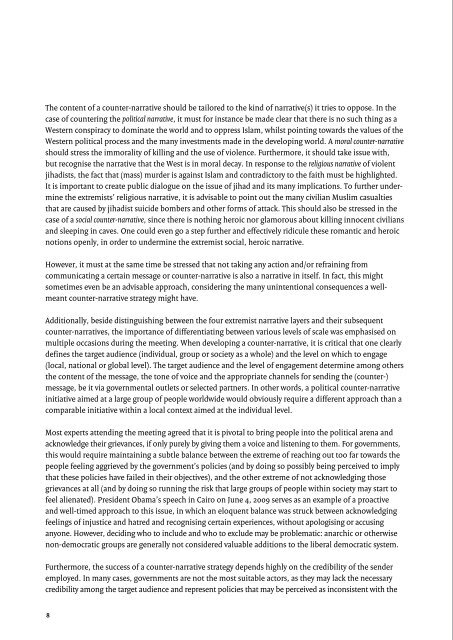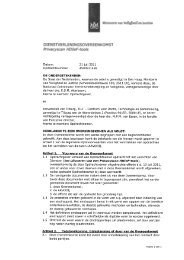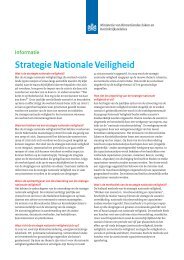Countering Violent Extremist Narratives
Countering Violent Extremist Narratives
Countering Violent Extremist Narratives
- No tags were found...
Create successful ePaper yourself
Turn your PDF publications into a flip-book with our unique Google optimized e-Paper software.
The content of a counter-narrative should be tailored to the kind of narrative(s) it tries to oppose. In thecase of countering the political narrative, it must for instance be made clear that there is no such thing as aWestern conspiracy to dominate the world and to oppress Islam, whilst pointing towards the values of theWestern political process and the many investments made in the developing world. A moral counter-narrativeshould stress the immorality of killing and the use of violence. Furthermore, it should take issue with,but recognise the narrative that the West is in moral decay. In response to the religious narrative of violentjihadists, the fact that (mass) murder is against Islam and contradictory to the faith must be highlighted.It is important to create public dialogue on the issue of jihad and its many implications. To further underminethe extremists’ religious narrative, it is advisable to point out the many civilian Muslim casualtiesthat are caused by jihadist suicide bombers and other forms of attack. This should also be stressed in thecase of a social counter-narrative, since there is nothing heroic nor glamorous about killing innocent civiliansand sleeping in caves. One could even go a step further and effectively ridicule these romantic and heroicnotions openly, in order to undermine the extremist social, heroic narrative.However, it must at the same time be stressed that not taking any action and/or refraining fromcommunicating a certain message or counter-narrative is also a narrative in itself. In fact, this mightsometimes even be an advisable approach, considering the many unintentional consequences a wellmeantcounter-narrative strategy might have.Additionally, beside distinguishing between the four extremist narrative layers and their subsequentcounter-narratives, the importance of differentiating between various levels of scale was emphasised onmultiple occasions during the meeting. When developing a counter-narrative, it is critical that one clearlydefines the target audience (individual, group or society as a whole) and the level on which to engage(local, national or global level). The target audience and the level of engagement determine among othersthe content of the message, the tone of voice and the appropriate channels for sending the (counter-)message, be it via governmental outlets or selected partners. In other words, a political counter-narrativeinitiative aimed at a large group of people worldwide would obviously require a different approach than acomparable initiative within a local context aimed at the individual level.Most experts attending the meeting agreed that it is pivotal to bring people into the political arena andacknowledge their grievances, if only purely by giving them a voice and listening to them. For governments,this would require maintaining a subtle balance between the extreme of reaching out too far towards thepeople feeling aggrieved by the government’s policies (and by doing so possibly being perceived to implythat these policies have failed in their objectives), and the other extreme of not acknowledging thosegrievances at all (and by doing so running the risk that large groups of people within society may start tofeel alienated). President Obama’s speech in Cairo on June 4, 2009 serves as an example of a proactiveand well-timed approach to this issue, in which an eloquent balance was struck between acknowledgingfeelings of injustice and hatred and recognising certain experiences, without apologising or accusinganyone. However, deciding who to include and who to exclude may be problematic: anarchic or otherwisenon-democratic groups are generally not considered valuable additions to the liberal democratic system.Furthermore, the success of a counter-narrative strategy depends highly on the credibility of the senderemployed. In many cases, governments are not the most suitable actors, as they may lack the necessarycredibility among the target audience and represent policies that may be perceived as inconsistent with themessage sent. An alternative would be to use other organisations (for example NGOs or local communityleaders) as intermediaries to bring the message across more effectively. However, one must take note of thedifficulties some of these other actors might have when working together with governments. For instance,whilst politics needs to be transparent and politicians require attention for what they are doing, certainother actors rather wish to conduct their work silently and independently, so as not to lose their credibility.More generally, it was deemed impossible and unwise for Western governments to aspire to control andemploy a central (counter-)narrative. Impossible, because they are often not deemed trustworthy or credible,because they lack the glamorous appeal of some of the other actors, and because they simply lack the controlover all the different individuals, groups and organisations that, both consciously and subconsciously, areengaged in public diplomacy and are sending out a message of their own. Unwise, because inconsistenciesin governmental policies, for instance between domestic and foreign policy or various government agencies,are inevitable and likely to be picked up by antagonists anyway. What governments can do is:• via various carefully chosen partners, promote multiple narratives;• facilitate these partners financially, logistically or content-wise;• be open and frank about inconsistencies;• support dialogue and peaceful discussion;• stimulate the Muslim community to take ownership of certain areas of the issue;• acknowledge grievances; and• appreciate that in a democratic society there will and should always be a pluralism of narrativesand discourses.Lastly, the experts agreed that different senders should be utilised for the different types of counternarratives.Whilst government leaders, communication experts and policy advisors are well suited todeal with the political counter-narrative, key members of civil society, representation groups andcommunity leaders are more credible as actors in a moral counter-narrative strategy. Since there wasgeneral agreement on the idea that government should steer clear of religious discussion, it is advisableto have Mullahs, Imams and Muslims in general engaged against the jihadist religious narrative. In the caseof a social counter-narrative, social workers, young Muslim peers, families and former violent extremistsshould be supported to promote the message that there is nothing heroic about a violent extremist’schosen path and reconnect radicalising individuals with the society at large.Structure of the volumeThe interesting roundtable discussions and thought-provoking presentations during the expert meetinginspired the NCTb and the CTC to compile this volume, in which the various chapters reflect and furtherdevelop the ideas presented and discussed during the meeting.In chapter 1, Beatrice de Graaf utilises the case of the German Federal Republic to illustrate the unintentionalmessages governments often unwittingly produce via their counterterrorism policies – messages thatcan sometimes completely contradict the official counter-narrative. Rogelio Alonso analyses the variouscounter-narratives put forward by different actors in their attempt to confront and neutralise ETA’sinterpretation of events in chapter 2. Next, Bob de Graaff turns to the importance of redefining the ‘us’and the ‘them’ in the discourse surrounding and influencing counterterrorism approaches of Westerngovernments. In chapter 4, Alex P. Schmid examines al-Qaeda’s ideology and offers various recommen-
















